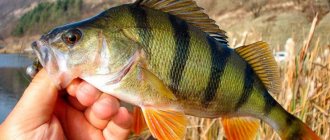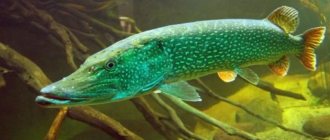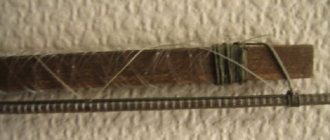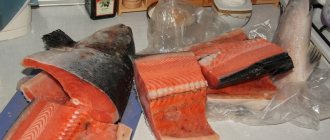Yuri 09.09.2020 410
Today, more and more people are interested in fishing. This kind of hobby is an exciting, exciting process. Here everyone can show experience, dexterity and talent. In addition to the fact that fishing allows you to have a good time, it allows you to become the owner of a good trophy. Any fisherman strives to catch a bigger fish. And, of course, the breed of fish matters. But few are interested in the age of the inhabitants of reservoirs.
Learning to determine how many years it took today’s trophy to deftly escape the fishing hook is not the easiest task. How can you figure out how old a fish is? There are several ways to do this:
- by scales;
- by bones;
- along the gills;
- to size.
How to determine age by scales
Scales help determine how long an individual has grown over the previous year, how old the fish is and how intensively it has grown. The scales are examined under a microscope, magnifying it several dozen times. This is the most universal method by which the age of fish is determined. The plate of scales is covered with small rings that are similar to the annual rings of trees. They are used to determine the age of various mammals, as well as mollusks. Each ring is located along the entire perimeter of the scale and is equal to 1 year of life.
Unlike aquatic life, the age of land animals is determined by bones and teeth. The formation of annual rings on fish scales occurs in winter, but sometimes they appear in summer and spring. How to properly research them:
- Damaged scales should not be used. They must be whole and large in size.
- The scales are washed with alcohol.
- If you look at the plates under a microscope, you can see not only rings, but also various depressions and ridges.
Gill covers can be used instead of scales. They have markings from which age is calculated. It is much more convenient to work with them, since their size is several times larger than scales.
How do annual rings appear in fish?
Age, reproductive capacity, and growth rate are all calculated from the rings. Studying the plates allows scientists to conduct appropriate analyzes and monitor the population of each individual, monitoring the environmental situation. If you carefully examine each ring, you will see that it has a wide light ring and a dark narrow one. What do they mean:
- Light rings indicate that the individual was rapidly developing and growing. This growth rate occurs in April.
- If conditions for development were unfavorable, then dark, narrow rings appear. This happens in winter.
All favorable and unfavorable development conditions are displayed on the bones and scales of fish in the form of layers. These formations are their peculiarity, which representatives of this fauna possess. A separate plate grown over the course of a year shows the conditions in which the individual lived throughout this period. It appears under last year's scales. If you count them, you can determine the age of the fish.
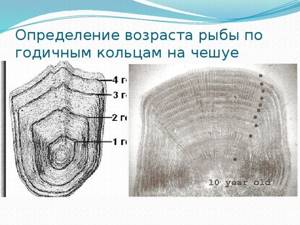
In some species, rings do not appear. This is due to the fact that the formation of a cover of scales does not begin to occur immediately, but 30-40 days after the larva leaves the egg. Transparent scales appear first. A second layer of thicker plates is formed in the second year of life. It appears under transparent scales. The third layer grows in the third year. An individual that reaches 7 years of age will have 7 rings.
Calculating age using rings
To calculate the age of a fish, you need to prepare everything you need. For research you will need a notepad, pen and calculator:
- To enlarge the picture 20 times, use a magnifying glass or binoculars. It is often used by professional fishermen.
- The work is carried out on a table, having previously covered it with a white cloth. Tools used include a knife and tweezers.
- The carcass is inspected and a suitable area for research is selected. It is better to choose otolith or spine.
- The selected area is thoroughly cleaned. Remove all blood and mucus. The fish can be placed in a container filled with diluted alcohol. After 5 minutes, the carcass is removed from the solution, and the area under study is wiped with a dry cloth.
- A visual line is drawn from the central point of the carcass to the fin. 15 records are taken from this area.
- The scales located in the fin area are not used, as they are difficult to see. Choose only solid plates with an even shape.
- If a microscope is used for research, then the width of each sclerite is calculated using a scaled eyepiece.
- All numbers are written down in a notebook and then calculated. The final numbers are her age.
The external state of the scales shows what happened to the fish throughout its life. The fish spawn when the scales break off. Therefore, the broken plates are used to determine how often an individual produced offspring.
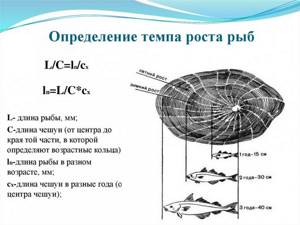
How do rings appear on scales?
To fully determine the age of the fish, you should know about the origin of these very rings. If you look closely, you will be able to notice that the rings are not uniformly arranged. For example, after the light ones there are longitudinal, darker ones. The black ring forms during periods of fasting of the fish, usually during cold winter periods. Layers on top of the fish’s body are formed depending on the living conditions of the fish. The more uniformly the scales were layered, the more comfortable the fish lived.
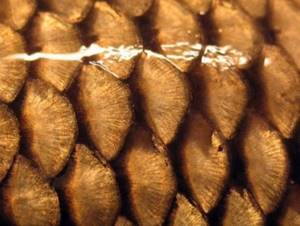
Remember that every year a fish lives will definitely leave a mark on its scales. At first, the scales are soft and transparent. After 12 months, another scale grows on top, extending beyond the edge of the first, and so on. Thus, if a fish is 6 years old, it will have scales of 6 plates on its body. It's kind of like a Napoleon layer cake. In this case, the oldest plate is always located at the very top.
Determining age from bones
What to do and how to find out the age of a fish if its scales are damaged or completely missing. Professional fishermen will be able to tell the entire life story of the fish, even if the material is damaged. But beginners will not be able to do this. Therefore, it is worth conducting a study of gill covers, ear stones, skulls, pectoral fins or bones, which will tell how the fish lived throughout the year. Determination process:
- Gill covers, vertebrae or skull bones are placed in a container of water. The contents are boiled for 5 minutes.
- Then all elements are treated with salicylic alcohol and wiped dry.
- A thin, even cut is made on each bone.
Then the fragments are placed under a microscope and the growth rings are calculated. You can learn to determine the age of caught fish up to 2 months if you practice and gain enough experience.
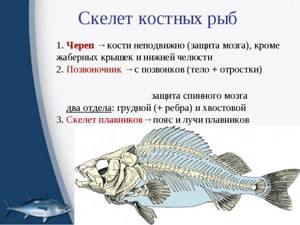
Determining the age of fish of different species
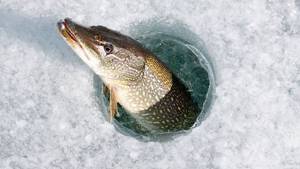
It is very easy to determine the age of pike, taimen, grayling, herring and many other species. The thinner and longer the fish scales, the easier it is to determine age.
It can be very difficult to determine the age of fish such as perch, burbot, and eel. In this case, flat bones are taken for examination. If you suddenly catch a sturgeon, then to determine its age you need to take the largest fin rays from the back.
After this, make a cross-section at the widest point and grind until completely transparent. Annual rings will appear on the fin. Next, an inspection is carried out, as in the case of scales. The age of catfish is determined in the same way.
In addition to the above method, age is perfectly determined by examining the gills. Each passing year leaves its mark on the gill covers. Scientists have discovered that even cartilaginous fish have their own annual rings. They are formed on thick rays, which are located in the places of the pectoral fins.
To obtain the most accurate forecast of the number of a particular species, it is necessary to know the dynamics of development of this species. Many of them reach sexual maturity quite late. For example, Amur salmon begins to spawn for the first time at the age of 20.
What are sclerites
Sclerites (ridges) are formations that appear on the outer layer of scales. The formation of rings in some individuals occurs in the spring. But for bream living in the Aral Sea, this period falls in the fall, and for pike perch from the Azov Sea - at the end of July. Formation of sclerites:
- An increase in the size of scales occurs along with the growth of the fish. And since the individual develops differently, the size of the scales also becomes different. This difference manifests itself in the form of sclerites and various scars. They have an arcuate or circular arrangement.
- The gap between the sclerites and their width can be narrow or wide. Thin zones are formed during slow development (in cold climates), and wide zones (in warm climates) during intensive development.
- The annual ring is determined by the outer line of nearby sclerites (narrowed growth area).
- The additional formations that appear show how the life cycle of an individual has changed over the year. Sclerites occur due to temperature changes in water, feeding method, spawning and the frequency of migration. In the area of the first year's ring, one can often see the manifestation of a fry ring.
Different types of fish have their own shape and size of scales.
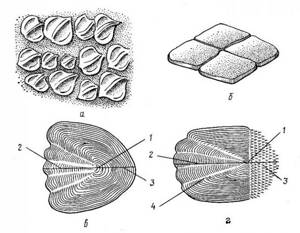
Ecological forms of perch
Any body of water more or less varied in bottom topography and size will be inhabited by two types of perches. The first ones, who from birth to old age will live near the coastline. The second group will be located in deep holes and dumps. At the same time, their food supply will differ significantly.
The diet of the coastal group includes mainly all invertebrates and seasonally young fish. The second group will start hunting for their fellow fish and other fish species early on. The calorie content of the feed will be different in both cases. And that means the growth rate. It may happen that a 15-centimeter perch and a one-kilogram humpback caught on the same day will turn out to be fry of the same season. And visually you can’t even tell that the age of the perch will be the same.
If the characteristics of the reservoir allow, then coastal and deep perch will be found. Even participate in reproduction. When a thermocline occurs in a reservoir, group meetings usually do not occur. Each lives its own life and reproduces in its own conditions. Races can meet during feeding. However, if the thermocline allows.
So it turns out that it is simply not possible to determine the age of a perch by size in centimeters and weight in grams. A fish weighing 200 grams may turn out to be 5-6 years old, or maybe one and a half years old.
Calculating the age of aquarium fish
When purchasing aquarium fish at a pet store, you may receive false information about their age. Therefore, you need to learn to determine their age yourself. But doing this with aquarium fish is much more difficult than with river fish. Main signs of old age:
- poor appetite;
- dull shade;
- lethargy;
- the fish moves weakly in the water.
Housekeeping conditions greatly affect the size of the fish and its color, and the scales are too small to determine age. Therefore, all these indicators sometimes mean that the fish is sick. Its mobility and bright coloring can return at any time.
We determine the exact age from tree rings without errors
Research in this area has been carried out for more than a century. More than 3 centuries ago, scientists realized that concentric lines located on its scales tell how old a fish is. They are compared to annual rings on the cut of a tree trunk.
Subsequent studies confirmed and described in more detail methods for determining the age of fish by sclerites-ridges on scales and bones. So each fish has a kind of personal document.
The annual pattern is not clearly visible on every scale, so it is better to examine the details under a microscope. Typically, large intact elements are taken from the middle of the fish’s side for research. After special processing, they tell a lot:
- The color tells about the growth periods of the fish: wide light parts indicate intensive growth.
- Narrow dark rings indicate a period of slowdown.
- Light rings are also called “summer”, and dark rings are called “winter”.
During fish spawning, additional rings appear on the scales. They also have a certain meaning. Thus, in the “summer” annual ring there may be a small additional ring - a spawning ring, which indicates starvation during the journey to the spawning site. It happens that spawning rings are visible better than annual rings due to damage to the scales. Often this ring is mistakenly included in the total number of years.
There is another method that is widespread, but it also requires certain skills.
The fish does not have an auditory opening, there is no auricle and no eardrum. The inner ear of the fish is taken for study. Inside it are otoliths in the form of white oblong grains. They clearly show concentric plates that are formed by the merging of light and dark rings. Together these rings form one annual ring. By the way, otoliths in young individuals are better defined than in adults.
